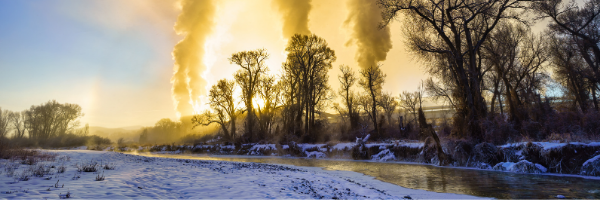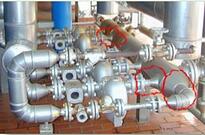Share this
10 Tips on Steam Heat Exchanger and Tracing System Design
by Katie Reid on Fri, Dec 18, 2020 @ 10:12 AM

It's critical to know the operational characteristics of where the system will function. Not knowing can lead to choosing the wrong components. Read on for details, then please click through for info on Steam System Audits and other help available to you:
Over 50+ years Edmonton Valve and Fitting has diagnosed and advised on hundreds of industrial steam heat exchangers and tracing systems throughout northern and central Alberta—where, as you know, temperatures can change nearly 200 °F in the space of a couple months. (Apparently a low of -78 °F has been recorded at Fort Vermilion, while 110 °F was recorded at Bassano Dam.)
 I posted a couple of weeks ago about steam sampling advice shared by Kelly Paffel and Tristian McCallion in a July technical briefing. Today I'm posting more of Paffel's advice.
I posted a couple of weeks ago about steam sampling advice shared by Kelly Paffel and Tristian McCallion in a July technical briefing. Today I'm posting more of Paffel's advice.
Paffel stresses that, to design a proper steam heat exchanger or steam heat tracing system, you first need to understand the operational characteristics of where the system will function. Failing to do so can lead to choosing the wrong components. And that can lead to premature failure or under-performance.
Below are 10 best practices to help you avoid these problems.
1. Eliminate condensate build-up and carryover
When there's low or no steam flow, condensate can accumulate prior to the inlet of the control valve. That can cause a water hammer. Additionally, any condensate passing through the steam control valve can cause premature failure of the valve.
You can eliminate the build-up of condensate in a number of ways: installing a drip leg prior to the valve, insulation improvement, correctly grading the steam line, or installing a steam separator prior to the valve.
2. Follow turndown ratio guidelines
Heat transfer components require properly sized control valves. A primary factor is the turndown capability, rangeability, or working range of the valve. Here are some turndown ratio guidelines for control valves:
- Cage control = 40:1 turndown ratio provides the most control
- Globe control valve = 30:1 turndown ratio
- Regulating valve = 20:1 turndown ratio
Incorrectly sized control valves can lead to poor process temperature control, premature wear of the valve seats and excessive noise.
3. Install pressure gauges
Install a pressure gauge before and after a control valve and on the condensate return leg after the steam trap. This provides accurate data to assist in understanding the pressure characteristics of the steam passing through the steam heat exchanger. Additionally, all pressure gauges should be installed with a coil siphon (pigtail) to prevent high-temperature damage, and double block isolation valves to allow maintenance.
4. Install vacuum breakers
Any steam system that can be isolated from the steam supply and is not open to atmosphere must have vacuum breakers. When steam cools down inside equipment, it will condense, forming a vacuum. Vacuum breakers protect steam systems from implosion when a system is shut down.
5. Install automatic air vents
Air gets into steam systems during shutdowns and maintenance, so it must be purged out before the system can be returned to service. Air in a steam heat exchanger system is often the cause for slow startups.
The most efficient ways to remove air is with a vent fitted on the end of a steam main, or at the highest point on an equipment in conjunction with a vacuum breaker. Don't rely on steam traps to vent air. They are located at the lowest point in the system, and hot air tends to be trapped at the highest point.
6. Avoid backpressure
If possible, heat transfer equipment should be installed to promote gravitational drainage with no vertical lift before or after steam traps. This is crucial in any application that has a modulating steam control valve.
Some applications do not permit gravitational drainage. In these cases, make sure that no undue backpressure is placed on condensate devices like steam traps or control valves. Too much backpressure can lead to premature failures, water hammer, inadequate temperature control, reduced efficiency and corrosion issues.
7. Prevent superheated steam
Typical steam heating applications require 100 percent saturated steam. But you don't want superheated steam, or steam at a higher temperature than its saturation point. Superheated steam contains less energy per unit volume than saturated steam and can cause performance problems. Superheated steam supply can be conditioned by installing a desuperheater.
8. Lockout ball valves
Ball valves can provide a safe, reliable and cost-effective solution for leak-tight isolation in a steam system. The handle orientation makes it easy to identify the isolation state. Ball valves two inches or smaller can be purchased with locking handles, providing the best safety practice for a lockout or tagout.
(View devices that can lock out in the closed or open position and can accommodate numerous sizes of stems and handles here.)
9. Carefully select steam traps
 Different mechanical designs for steam traps cater to different applications. Some are more reliable than others. For steam heat exchanger applications, a mechanical type steam trap is best suited for modulating flow. For steam heat tracing, a variety of steam trap types can work, depending on application needs. Also consider sizing based on maximum and minimum flow, requirements for priming, air venting, functional testing and mounting options.
Different mechanical designs for steam traps cater to different applications. Some are more reliable than others. For steam heat exchanger applications, a mechanical type steam trap is best suited for modulating flow. For steam heat tracing, a variety of steam trap types can work, depending on application needs. Also consider sizing based on maximum and minimum flow, requirements for priming, air venting, functional testing and mounting options.
You can test steam traps without special equipment by installing a downstream bypass, making it easy to visually check the condensate discharge.
10. Install a strainer
Corrosion and its byproducts can contaminate steam lines, especially within the control valve trims, isolation valve seats, and steam trap seats. A strainer will act as a filter, keeping foreign materials out of the steam system.
When installing the strainer, always install a blowdown valve with a lockout facility, and vent the discharge from the valve to a safe location. Be sure to install the strainer with the straining section in the horizontal position to prevent accumulation of condensate within the strainer body.
Learn about Swagelok Field Advisory Services

Edmonton Valve invites you to take advantage of Swagelok Field Advisory Services. If you choose a Steam System Audit, for example, we can pinpoint energy losses, document areas needing attention, and provide a detailed report on where to focus. Getting started creates no cost or obligation.
Our local field service technicians have deep experience with fluid system applications for oil & gas, chem refining, power, midstream, and steam-assisted gravity drainage (SAGD) companies. They can address steam systems, analyzer sample conditioning systems, grab sampling systems, mechanical seal support systems for rotating equipment, gas distribution systems, instrumentation pigtails, point-of-use manifolding, manifolding for multiple gas cylinders, regulator changeover manifolds, purge panels, and more.
Need technical help right now? Call our 24x7 Field Advisory Services On-Call Technical Support: 780-237-7109. (For general support, please call 780.437.0640.)
Also see:
Share this
- Local Services (103)
- Field Advisors (101)
- Training & Events (86)
- Fittings (81)
- Valves (66)
- Resources (62)
- Tubing (62)
- Sampling Systems (60)
- Design & Assembly (57)
- Resources - Downloads (40)
- Hose & Flexible Tubing (39)
- Frequently Asked Questions (37)
- Regulators (34)
- Cost Savings (33)
- Oil & Gas (33)
- Videos (33)
- Steam Systems (29)
- Mechanical Seal Support (17)
- Measurement Devices (15)
- Gas Distribution Systems (9)
- Rentals (6)
- winterization (6)
- Safety (5)
- Covid (3)
- Hydrogen & Clean Energy (2)
- About Us (1)
- April 2024 (2)
- March 2024 (2)
- January 2024 (3)
- December 2023 (2)
- November 2023 (3)
- October 2023 (2)
- September 2023 (3)
- August 2023 (3)
- July 2023 (3)
- June 2023 (2)
- May 2023 (4)
- April 2023 (2)
- March 2023 (2)
- February 2023 (3)
- January 2023 (2)
- December 2022 (1)
- November 2022 (1)
- October 2022 (2)
- September 2022 (5)
- August 2022 (3)
- July 2022 (6)
- June 2022 (4)
- May 2022 (3)
- April 2022 (1)
- March 2022 (2)
- February 2022 (3)
- January 2022 (4)
- December 2021 (4)
- November 2021 (6)
- October 2021 (3)
- September 2021 (5)
- August 2021 (9)
- July 2021 (5)
- June 2021 (7)
- May 2021 (7)
- April 2021 (4)
- March 2021 (3)
- February 2021 (3)
- January 2021 (2)
- December 2020 (3)
- November 2020 (3)
- October 2020 (2)
- September 2020 (3)
- August 2020 (3)
- July 2020 (3)
- June 2020 (3)
- May 2020 (3)
- April 2020 (2)
- March 2020 (3)
- February 2020 (3)
- January 2020 (3)
- December 2019 (2)
- November 2019 (3)
- October 2019 (3)
- September 2019 (2)
- August 2019 (3)
- July 2019 (2)
- June 2019 (2)
- May 2019 (3)
- April 2019 (3)
- March 2019 (3)
- February 2019 (2)
- January 2019 (3)
- December 2018 (2)
- November 2018 (2)
- October 2018 (4)
- September 2018 (2)
- August 2018 (3)
- July 2018 (3)
- June 2018 (2)
- May 2018 (4)
- April 2018 (3)
- March 2018 (3)
- February 2018 (3)
- January 2018 (4)
- December 2017 (1)
- November 2017 (4)
- October 2017 (4)
- September 2017 (4)
- August 2017 (5)
- July 2017 (3)
- June 2017 (4)
- May 2017 (4)
- April 2017 (3)
- March 2017 (5)
- February 2017 (4)
- January 2017 (4)
- December 2016 (3)
- November 2016 (3)
- October 2016 (4)
- September 2016 (3)
- August 2016 (4)
- July 2016 (2)
- June 2016 (2)
- May 2016 (2)
- April 2016 (4)
- March 2016 (2)
- February 2016 (3)
- January 2016 (4)
- December 2015 (4)
- November 2015 (4)
- October 2015 (5)
- September 2015 (2)
- August 2015 (4)
- July 2015 (5)
- June 2015 (2)
- May 2015 (3)
- April 2015 (5)
- March 2015 (3)
- February 2015 (4)
- January 2015 (3)
- December 2014 (5)
- November 2014 (4)
- October 2014 (4)
- September 2014 (4)
- August 2014 (4)
- July 2014 (5)
- June 2014 (4)
- May 2014 (4)
- April 2014 (5)
- March 2014 (4)
- February 2014 (4)
- January 2014 (4)
- December 2013 (3)
- November 2013 (4)
- October 2013 (5)
- September 2013 (4)
- August 2013 (5)
- July 2013 (4)
- June 2013 (3)
- May 2013 (4)
- April 2013 (5)
- March 2013 (2)
- February 2013 (3)
- January 2013 (5)
- December 2012 (3)
- November 2012 (3)
- October 2012 (5)
- September 2012 (3)
- August 2012 (4)
- July 2012 (4)
- June 2012 (1)



